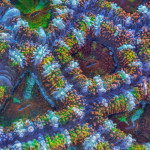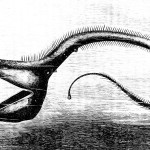Texas A&M University researcher Brendan Roark announced last week at American Association for the Advancement of Science (AAAS) that age and growth studies of deep-sea gold corals (Geradia sp.) and black corals (Leiopathes glaberrima, pictured left) indicate these animals live between two and four millennia, repectively. Science Magazine covers the story here, the press release is here, and Discover Magazine reports here.
The new findings break all records previously claimed for marine invertebrates like the cold seep tubeworms (estimated 200 years old), quahog clams (estimated 400 years old), as well as the deep-sea wannabees Primnoa spp. and bamboo corals (45 – 300 years old). Given the new results, deep-sea animals can finally measure up to the longevity of the “Methuselah tree”, the Bristlecone Pine, estimated to be near 5000 years old.
Deep-sea biologists get excited about this because marine invertebrates record archives of environmental conditions in their growth rings, the same way trees do. Long lived invertebrates provide long records of climate change in the deep sea. We’re likely to channel Jacques Cousteau or Carl Sagan saying (cue accent)…
They are like [little] tiny tape-recorders, … sitting on the sea-bed… integrating signals about water temperature and food over time
– C. Richardson, Bangor University
Gerardia sp. colonies have been clocked at an estimated 1800 years since 1995 based on carbon isotopes and a few assumptions that the surface derived carbon is constant and growth is linear (Druffel et al 1995). Scientsts were skeptical, though. A researcher who studied growth rates in the field once told me… “there is one thing we can’t avoid, and that’s reality.” Yet, the new results from Hawaiian deep-sea coral cruises seem to bear out these hypotheses showing that 1800 years is almost like middle-age for a gold or a black coral.
Unfortunately, these are perhaps two of the most highly valued coral families in the jewelry trade, along with precious corals in the Corallidae. Corallium niobe colonies can be 200 years old (Druffel et al 1990). The Convention for International Trade in Endangered Species (CITES) is trying to crack down on international trade for these species. Meanwhile jewelery distributors are switching to harvests of the faster growing bamboo corals, which they tumble smooth and dye red in an attempt to match the color of Corallium. Jewelers beware!
If you’re out there trawling for caveats, perhaps the most important thing to mention is that gold and black corals are colonial zoantharians. No single polyp is thought to be this old, just the skeletal axis. The colonies are closely related to the cute green polypoid things you see scattered around salt water aquaria at the tropical fish store. If the living colony were to be decimated by a predatory sea star, for example, zoantharian larvae might recruit to the axis and re-establish themselves. This has been suggested by Noe and Dullo (2005), who found two periods of relaxed growth in their studies of a 300 year old bamboo coral. They suggest that during this time, the colony expired, and was later recolonized.
One of the more recent papers describing the techniques and findings by Roark, Guilderson, Dunbar, and Ingram (2006) is freely available online as an open access article at the Marine Ecology Progress Series. The recent presentation at AAAS includes new material, and new findings.






If you’re out there trawling for caveats…
Nice peter, real poetic.
This is a great story and I’m a little to hear the tubeworms are beat out. At least its by a cnidarian! I wonder how old those Lophelia reefs are off of Norway. They sound like they are quite extensive and deep. The problem is figuring out it there is one individual colony or a conglomeration of colonies. What if a colony breaks off a chunk, rolls down the slope a little, establishes but grows into its mother colony. They are genetically identical (clones), but now separate individual colonies. Mind-warping.
Ironically, directly above these ancient corals is one of the newest challenges to man’s wellbeing. Sailors call the relatively calm center of the North Pacific Gyre the “Horse Latitudes” and usually try to avoid getting stuck there without wind and current to pull them out. Today that calm center has been filled with a collection of floating plastic, a garbage patch roughly the size of Texas.
Problem is that birds and fish feeding there eat the plastic and either die or assimilate the plastic’s toxins into the food chain which will find it’s way to you and me. It’s an immense new problem that needs to be studied and remedied, starting now.
The Environmental Cleanup Coalition (ECC) is an independent, non-profit group organizing the Gyre Cleanup Project. The Gyre Cleanup Project is a large scale ocean rescue mission focused on removing debris accumulating in the North Pacific Gyre, revitalizing an ecosystem choking on human garbage, educating the public about the danger of plastics and advocating a culture that takes responsibility for its waste.
http://gyrecleanup.org
http://www.vimeo.com/3278233